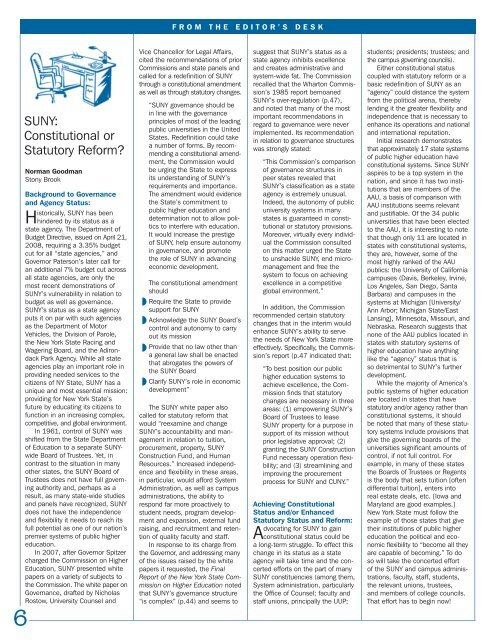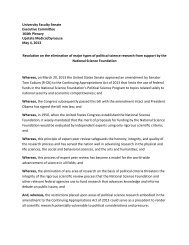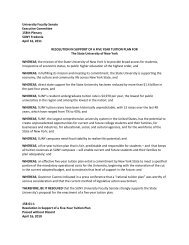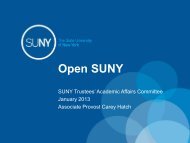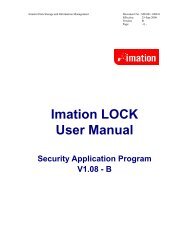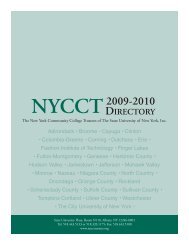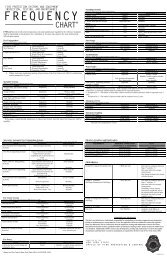Layout 1 copy - The State University of New York
Layout 1 copy - The State University of New York
Layout 1 copy - The State University of New York
Create successful ePaper yourself
Turn your PDF publications into a flip-book with our unique Google optimized e-Paper software.
F R O M T H E E D I T O R ’ S D E S K<br />
6<br />
SUNY:<br />
Constitutional or<br />
Statutory Reform?<br />
Norman Goodman<br />
Stony Brook<br />
Background to Governance<br />
and Agency Status:<br />
Historically, SUNY has been<br />
hindered by its status as a<br />
state agency. <strong>The</strong> Department <strong>of</strong><br />
Budget Directive, issued on April 21,<br />
2008, requiring a 3.35% budget<br />
cut for all “state agencies,” and<br />
Governor Paterson’s later call for<br />
an additional 7% budget cut across<br />
all state agencies, are only the<br />
most recent demonstrations <strong>of</strong><br />
SUNY’s vulnerability in relation to<br />
budget as well as governance.<br />
SUNY’s status as a state agency<br />
puts it on par with such agencies<br />
as the Department <strong>of</strong> Motor<br />
Vehicles, the Division <strong>of</strong> Parole,<br />
the <strong>New</strong> <strong>York</strong> <strong>State</strong> Racing and<br />
Wagering Board, and the Adirondack<br />
Park Agency. While all state<br />
agencies play an important role in<br />
providing needed services to the<br />
citizens <strong>of</strong> NY <strong>State</strong>, SUNY has a<br />
unique and most essential mission:<br />
providing for <strong>New</strong> <strong>York</strong> <strong>State</strong>’s<br />
future by educating its citizens to<br />
function in an increasing complex,<br />
competitive, and global environment.<br />
In 1961, control <strong>of</strong> SUNY was<br />
shifted from the <strong>State</strong> Department<br />
<strong>of</strong> Education to a separate SUNYwide<br />
Board <strong>of</strong> Trustees. Yet, in<br />
contrast to the situation in many<br />
other states, the SUNY Board <strong>of</strong><br />
Trustees does not have full governing<br />
authority and, perhaps as a<br />
result, as many state-wide studies<br />
and panels have recognized, SUNY<br />
does not have the independence<br />
and flexibility it needs to reach its<br />
full potential as one <strong>of</strong> our nation’s<br />
premier systems <strong>of</strong> public higher<br />
education.<br />
In 2007, after Governor Spitzer<br />
charged the Commission on Higher<br />
Education, SUNY presented white<br />
papers on a variety <strong>of</strong> subjects to<br />
the Commission. <strong>The</strong> white paper on<br />
Governance, drafted by Nicholas<br />
Rostow, <strong>University</strong> Counsel and<br />
Vice Chancellor for Legal Affairs,<br />
cited the recommendations <strong>of</strong> prior<br />
Commissions and state panels and<br />
called for a redefinition <strong>of</strong> SUNY<br />
through a constitutional amendment<br />
as well as through statutory changes.<br />
“SUNY governance should be<br />
in line with the governance<br />
principles <strong>of</strong> most <strong>of</strong> the leading<br />
public universities in the United<br />
<strong>State</strong>s. Redefinition could take<br />
a number <strong>of</strong> forms. By recommending<br />
a constitutional amendment,<br />
the Commission would<br />
be urging the <strong>State</strong> to express<br />
its understanding <strong>of</strong> SUNY’s<br />
requirements and importance.<br />
<strong>The</strong> amendment would evidence<br />
the <strong>State</strong>’s commitment to<br />
public higher education and<br />
determination not to allow politics<br />
to interfere with education.<br />
It would increase the prestige<br />
<strong>of</strong> SUNY, help ensure autonomy<br />
in governance, and promote<br />
the role <strong>of</strong> SUNY in advancing<br />
economic development.<br />
<strong>The</strong> constitutional amendment<br />
should<br />
Require the <strong>State</strong> to provide<br />
support for SUNY<br />
Acknowledge the SUNY Board’s<br />
control and autonomy to carry<br />
out its mission<br />
Provide that no law other than<br />
a general law shall be enacted<br />
that abrogates the powers <strong>of</strong><br />
the SUNY Board<br />
Clarify SUNY’s role in economic<br />
development”<br />
◗<br />
◗<br />
◗<br />
◗<br />
<strong>The</strong> SUNY white paper also<br />
called for statutory reform that<br />
would “reexamine and change<br />
SUNY’s accountability and management<br />
in relation to tuition,<br />
procurement, property, SUNY<br />
Construction Fund, and Human<br />
Resources.” Increased independence<br />
and flexibility in these areas,<br />
in particular, would afford System<br />
Administration, as well as campus<br />
administrations, the ability to<br />
respond far more proactively to<br />
student needs, program development<br />
and expansion, external fund<br />
raising, and recruitment and retention<br />
<strong>of</strong> quality faculty and staff.<br />
In response to its charge from<br />
the Governor, and addressing many<br />
<strong>of</strong> the issues raised by the white<br />
papers it requested, the Final<br />
Report <strong>of</strong> the <strong>New</strong> <strong>York</strong> <strong>State</strong> Commission<br />
on Higher Education noted<br />
that SUNY’s governance structure<br />
“is complex” (p.44) and seems to<br />
suggest that SUNY’s status as a<br />
state agency inhibits excellence<br />
and creates administrative and<br />
system-wide fat. <strong>The</strong> Commission<br />
recalled that the Wharton Commission’s<br />
1985 report bemoaned<br />
SUNY’s over-regulation (p.47),<br />
and noted that many <strong>of</strong> the most<br />
important recommendations in<br />
regard to governance were never<br />
implemented. Its recommendation<br />
in relation to governance structures<br />
was strongly stated:<br />
“This Commission’s comparison<br />
<strong>of</strong> governance structures in<br />
peer states revealed that<br />
SUNY’s classification as a state<br />
agency is extremely unusual.<br />
Indeed, the autonomy <strong>of</strong> public<br />
university systems in many<br />
states is guaranteed in constitutional<br />
or statutory provisions.<br />
Moreover, virtually every individual<br />
the Commission consulted<br />
on this matter urged the <strong>State</strong><br />
to unshackle SUNY, end micromanagement<br />
and free the<br />
system to focus on achieving<br />
excellence in a competitive<br />
global environment.”<br />
In addition, the Commission<br />
recommended certain statutory<br />
changes that in the interim would<br />
enhance SUNY’s ability to serve<br />
the needs <strong>of</strong> <strong>New</strong> <strong>York</strong> <strong>State</strong> more<br />
effectively. Specifically, the Commission’s<br />
report (p.47 indicated that:<br />
“To best position our public<br />
higher education systems to<br />
achieve excellence, the Commission<br />
finds that statutory<br />
changes are necessary in three<br />
areas: (1) empowering SUNY’s<br />
Board <strong>of</strong> Trustees to lease<br />
SUNY property for a purpose in<br />
support <strong>of</strong> its mission without<br />
prior legislative approval; (2)<br />
granting the SUNY Construction<br />
Fund necessary operation flexibility;<br />
and (3) streamlining and<br />
improving the procurement<br />
process for SUNY and CUNY.”<br />
Achieving Constitutional<br />
Status and/or Enhanced<br />
Statutory Status and Reform:<br />
Advocating for SUNY to gain<br />
constitutional status could be<br />
a long-term struggle. To effect this<br />
change in its status as a state<br />
agency will take time and the concerted<br />
efforts on the part <strong>of</strong> many<br />
SUNY constituencies (among them,<br />
System administration, particularly<br />
the Office <strong>of</strong> Counsel; faculty and<br />
staff unions, principally the UUP;<br />
students; presidents; trustees; and<br />
the campus governing councils).<br />
Either constitutional status<br />
coupled with statutory reform or a<br />
basic redefinition <strong>of</strong> SUNY as an<br />
“agency” could distance the system<br />
from the political arena, thereby<br />
lending it the greater flexibility and<br />
independence that is necessary to<br />
enhance its operations and national<br />
and international reputation.<br />
Initial research demonstrates<br />
that approximately 17 state systems<br />
<strong>of</strong> public higher education have<br />
constitutional systems. Since SUNY<br />
aspires to be a top system in the<br />
nation, and since it has two institutions<br />
that are members <strong>of</strong> the<br />
AAU, a basis <strong>of</strong> comparison with<br />
AAU institutions seems relevant<br />
and justifiable. Of the 34 public<br />
universities that have been elected<br />
to the AAU, it is interesting to note<br />
that though only 11 are located in<br />
states with constitutional systems,<br />
they are, however, some <strong>of</strong> the<br />
most highly ranked <strong>of</strong> the AAU<br />
publics: the <strong>University</strong> <strong>of</strong> California<br />
campuses (Davis, Berkeley, Irvine,<br />
Los Angeles, San Diego, Santa<br />
Barbara) and campuses in the<br />
systems at Michigan [<strong>University</strong>/<br />
Ann Arbor; Michigan <strong>State</strong>/East<br />
Lansing], Minnesota, Missouri, and<br />
Nebraska. Research suggests that<br />
none <strong>of</strong> the AAU publics located in<br />
states with statutory systems <strong>of</strong><br />
higher education have anything<br />
like the “agency” status that is<br />
so detrimental to SUNY’s further<br />
development.<br />
While the majority <strong>of</strong> America’s<br />
public systems <strong>of</strong> higher education<br />
are located in states that have<br />
statutory and/or agency rather than<br />
constitutional systems, it should<br />
be noted that many <strong>of</strong> these statutory<br />
systems include provisions that<br />
give the governing boards <strong>of</strong> the<br />
universities significant amounts <strong>of</strong><br />
control, if not full control. For<br />
example, in many <strong>of</strong> these states<br />
the Boards <strong>of</strong> Trustees or Regents<br />
is the body that sets tuition [<strong>of</strong>ten<br />
differential tuition], enters into<br />
real estate deals, etc. [Iowa and<br />
Maryland are good examples.]<br />
<strong>New</strong> <strong>York</strong> <strong>State</strong> must follow the<br />
example <strong>of</strong> those states that give<br />
their institutions <strong>of</strong> public higher<br />
education the political and economic<br />
flexibility to “become all they<br />
are capable <strong>of</strong> becoming.” To do<br />
so will take the concerted effort<br />
<strong>of</strong> the SUNY and campus administrations,<br />
faculty, staff, students,<br />
the relevant unions, trustees,<br />
and members <strong>of</strong> college councils.<br />
That effort has to begin now!


